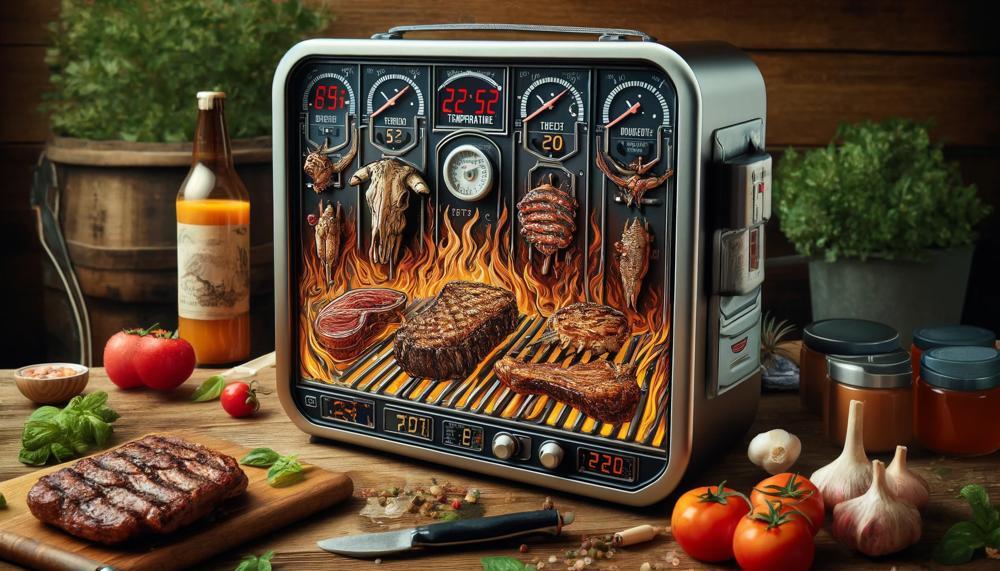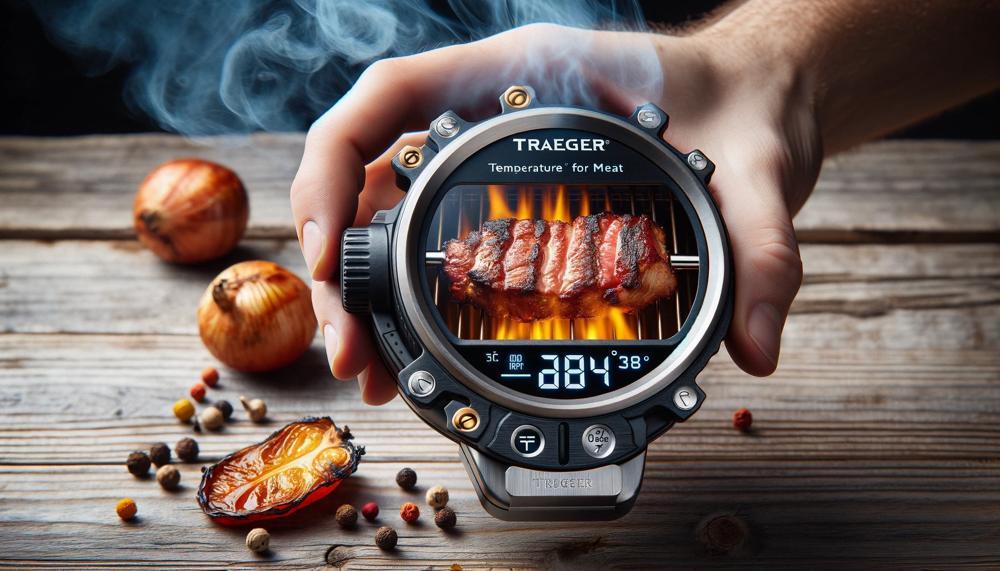Are you ready to grill like a pro? This grill is a must-have for anyone who loves grilling in their backyard because it is known for cooking meat to perfection. But there are a few important things you need to know about getting the Traeger to the right temperature for cooking meat.
You can always get juicy, delicious food on a Traeger grill if you know how to control the temperature. That’s what this blog post is all about.
Get ready to improve your cooking skills and wow your family and friends with delicious meat from your Traeger.
So, what temperature should a traeger be for meat?
The temperature for cooking meat on a Traeger grill varies depending on the type of meat:
- Chicken: The USDA-recommended safe serving temperature for chicken is 165 degrees Fahrenheit. This applies to both whole and ground chicken.
- Turkey: The recommended safe serving temperature for turkey is also 165 degrees Fahrenheit.
- Steak: The USDA-recommended safe serving temperature for steak is 145 degrees Fahrenheit. An internal temperature of 145 degrees will give you a well-done steak.
Let’s get started.
Contents
- 1 What Temperature Should A Traeger Be For Meat?
- 2 The Importance of Temperature in Cooking Meat on a Traeger Grill
- 3 Recommended Temperatures for Different Types of Meat on a Traeger Grill
- 4 Factors to Consider When Determining the Ideal Temperature for Cooking Meat on a Traeger Grill
- 5 Tips for Achieving Perfectly Cooked Meat on Your Traeger Grill
- 6 Common Mistakes to Avoid When Cooking Meat on a Traeger Grill
- 7 The Role of Internal Temperature and How to Use a Meat Thermometer with Your Traeger Grill
- 8 Conclusion
What Temperature Should A Traeger Be For Meat?
The ideal temperature for cooking meat on a Traeger grill is not a one-size-fits-all approach. It is influenced by factors such as the type of meat, the cut of meat, and individual preferences for doneness.
However, a general guideline is to cook meat within the range of 180-450°F (82-232°C) on a Traeger grill. To ensure that the meat is cooked to perfection, use a meat thermometer to check the internal temperature before serving.
It is also crucial to use top-quality wood pellets and regularly maintain the grill for optimal performance.
The Importance of Temperature in Cooking Meat on a Traeger Grill
When cooking meat on a Traeger grill, the temperature is a vital factor that directly affects the final outcome of the dish.
The following are a few reasons why the temperature of a Traeger grill is crucial when cooking meat:
- Proper Cooking: The correct temperature ensures that the meat is thoroughly cooked and reaches the desired level of doneness. Incomplete cooking can result in foodborne illnesses, while overcooking can lead to dry and tough meat.
- Flavor and Texture: Achieving the perfect flavor and texture of the meat depends heavily on the Traeger grill’s temperature. Different types of meat require different temperatures for optimal cooking, and the wide temperature range of the Traeger grill allows for versatile cooking options.
- Heat Maintenance: External factors and other conditions can affect the grill’s heat-producing ability, resulting in unevenly cooked food. To consistently achieve delicious results, it is crucial to maintain proper heat levels through regular maintenance and using high-quality wood pellets.
- Safety: The Traeger grill’s temperature range also ensures safe cooking and prevents any potential hazards that may arise from undercooked or overcooked meat.
- Efficient Cooking: By using the Traeger grill at the right temperature, one can save time and energy while still producing delicious results.
To sum up, the importance of temperature in cooking meat on a Traeger grill cannot be overstated as it directly impacts the safety, flavor, texture, and overall success of the dish.
Recommended Temperatures for Different Types of Meat on a Traeger Grill
When it comes to cooking meat on a Traeger grill, it’s crucial to know the recommended temperatures for each type of meat. These temperatures can vary depending on the thickness and size of the meat, so it’s best to use a meat thermometer to ensure the internal temperature is just right before serving.
It’s also important to let the meat rest for a few minutes after cooking to allow the juices to redistribute and ensure a tender and juicy dish.
Below are the recommended temperature ranges for different types of meat on a Traeger grill:

| Meat Type | Temperature Range | Internal Temperature |
| Beef | 130°F to 155°F | Rare: 130°F – 135°F Medium-Rare: 140°F – 145°F Medium: 155°F – 160°F Well Done: 160°F – 170°F |
| Poultry | 165°F to 175°F | 165°F (White and Dark Meat) |
| Pork | 145°F to 160°F | Medium-Rare: 145°F – 150°F Medium: 155°F – 160°F Well Done (Ground Pork/Sausages): 165°F |
| Lamb | 130°F to 160°F | Rare: 130°F – 135°F Medium-Rare: 140°F – 145°F Well Done: 160°F |
| Fish | 130-140°F | Rare:130°F – 135°F Medium-Rare: 145°F – 150°F Well Done: 150°F – 160°F |
| Seafood | 145-160°F | N/A (Cook until opaque and firm) |
It is important to keep in mind that these temperatures are just a general guideline and may need to be adjusted based on the specific cut of meat.
However, using a meat thermometer can help ensure that the meat is cooked to perfection.
Factors to Consider When Determining the Ideal Temperature for Cooking Meat on a Traeger Grill
To ensure mouth-watering and perfectly cooked meat on a Traeger grill, there are several key factors to keep in mind when determining the ideal temperature.
- Type of Meat: It is crucial to note that different types of meat require different cooking temperatures to achieve the desired level of doneness. For instance, beef can be cooked at a higher temperature than poultry to achieve the same level of doneness.
- Internal Temperature: To accurately gauge the internal temperature of the meat, it is essential to use a meat thermometer. This will prevent undercooking or overcooking and guarantee the perfect level of doneness.
- Traeger Grill Temperature Range: Compared to most grills, the Traeger grill has a higher temperature range with a maximum of 450℉. Understanding this range and its impact on cooking various types of meat is crucial.
- Quality of Wood Pellets: The type and quality of wood pellets used in the grill can significantly affect the heat and temperature range. Low-quality pellets may not produce enough heat, while high-quality pellets can achieve higher temperatures.
- External Conditions: External factors like weather, humidity, and even the age of the grill can also influence heat retention and temperature range. These factors should be taken into consideration when determining the ideal cooking temperature for your Traeger grill.
In summary, when determining the ideal temperature for cooking meat on a Traeger grill, it is vital to consider the type of meat, internal temperature, Traeger grill temperature range, quality of wood pellets, and external conditions.
By taking all these factors into account, you can achieve perfectly cooked meat every time, ensuring a delicious meal for you and your guests.
Tips for Achieving Perfectly Cooked Meat on Your Traeger Grill
To achieve a perfectly cooked meat on your Traeger grill, there are several factors to consider. Your meat’s thickness, the type of wood pellets you use, the temperature settings, and even the cleanliness of your grill can all impact the final result.
Firstly, make sure to preheat your grill for a longer period of time to allow it to reach the desired temperature. For different types of meat, the recommended temperature can vary, but it generally falls within the range of 180-450°F (82-232°C). To determine the ideal temperature for your specific meat, take into account its recommended internal temperature and your desired level of doneness.
When setting the temperature, it is also important to utilize airflow techniques and a heat deflector plate to evenly distribute heat and prevent any hot spots. This will ensure that your meat cooks evenly and reaches the desired internal temperature without any risk of overcooking or undercooking.
In addition, using a meat thermometer is crucial for monitoring the internal temperature of your meat. This will help you determine when your meat has reached the recommended temperature and is cooked to perfection.
Lastly, patience is key when cooking on a Traeger grill. It may take longer than traditional grills, but the end result will be worth it. By following these tips and being mindful of all the different factors that impact cooking on a Traeger grill, you can achieve perfectly cooked meat every time.
Common Mistakes to Avoid When Cooking Meat on a Traeger Grill
When it comes to cooking meat on a Traeger grill, there are a few common mistakes that many people make. These include neglecting to preheat the grill, failing to use a meat thermometer, and not properly seasoning the meat.
One of the most common mistakes people make when cooking on a Traeger grill is not preheating it. Preheating allows the grill to reach the proper temperature before adding the meat, which is key to achieving an even cook. Skipping this step can result in unevenly cooked or even undercooked meat. Therefore, preheating your Traeger grill is essential for a successful and delicious meal.
Another mistake that often leads to over- or undercooked meat is not using a meat thermometer. While many experienced cooks can tell when meat is done by touch or sight, using a thermometer ensures that the meat is cooked to perfection without any guesswork. This is especially important for larger cuts of meat that require longer cooking times, as they can easily become overcooked if not monitored closely.
Properly seasoning the meat is another crucial step in achieving a tasty meal on your Traeger grill. Seasoning should be done well in advance, allowing the flavors to fully infuse into the meat before cooking. This not only adds depth and richness to the flavor but also helps to tenderize the meat for a more enjoyable eating experience.
In addition to these key steps, closely monitoring temperature settings and allowing the cooked meat to rest for a few minutes before serving can greatly enhance your dish.
The Role of Internal Temperature and How to Use a Meat Thermometer with Your Traeger Grill
When using your Traeger grill to cook different types of meat, it is crucial to keep in mind that the recommended internal temperature can vary based on the type and cut of the meat. To ensure safe consumption, it is important to use a meat thermometer and cook the meat to its appropriate internal temperature.
Take a look at the table below for a breakdown of the recommended internal temperatures for various types of meat when cooking on your Traeger grill:
| Meat Type | Recommended Internal Temperature |
|---|---|
| Chicken | A minimum of 165°F (74°C) |
| Beef (steaks, roasts, and burgers) | Medium rare: 145°F (63°C) | Medium: 160°F (71°C) | Well done: 170°F (77°C) |
| Pork (chops and roasts) | A minimum of 145°F (63°C) |
| Turkey | A minimum of 165°F (74°C) |
| Fish | A minimum of 145°F (63°C) |
It is worth noting that these temperatures are only minimum recommendations and that some individuals may prefer their meat cooked to higher temperatures based on personal preference. It is also worth mentioning that thicker cuts of meat may require longer cooking times, resulting in a higher internal temperature.
Conclusion
In conclusion, mastering the art of cooking meat on a Traeger grill requires meticulous attention to detail and a thorough understanding of the various factors that contribute to temperature control.
From properly preheating the grill to utilizing a meat thermometer for precise cooking, there are several crucial steps that must be taken in order to achieve succulent and flavorful results.
It is imperative to keep in mind the recommended internal temperatures for different types of meat and utilize high-quality wood pellets for optimal heat retention.






